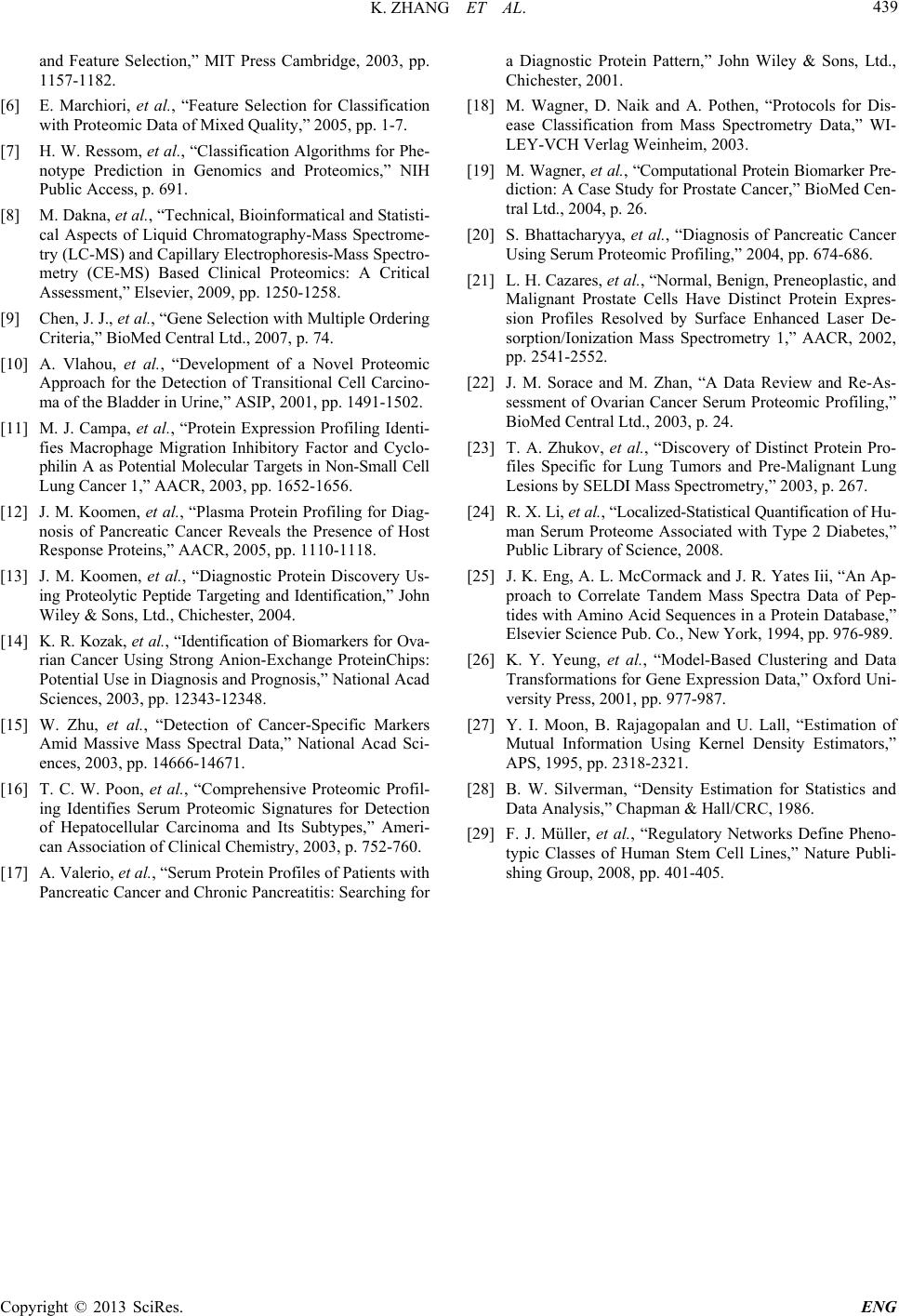
K. ZHANG ET AL.
Copyright © 2013 SciRes. ENG
439
and Feature Selection,” MIT Press Cambridge, 2003, pp.
1157-1182.
[6] E. Marchiori, et al., “Feature Selection for Classification
with Proteomic Data of Mixed Quality,” 2005, pp. 1-7.
[7] H. W. Ressom, et al., “Classification Algorithms for Phe-
notype Prediction in Genomics and Proteomics,” NIH
Public Access, p. 691.
[8] M. Dakna, et al., “Technical, Bioinformatical and Statisti-
cal Aspects of Liquid Chromatography-Mass Spectrome-
try (LC-MS) and Capillary Electrophoresis-Mass Spectro-
metry (CE-MS) Based Clinical Proteomics: A Critical
Assessment,” Elsevier, 2009, pp. 1250-1258.
[9] Chen, J. J., et al., “Gene Selection with Multiple Ordering
Criteria,” BioMed Central Ltd., 2007, p. 74.
[10] A. Vlahou, et al., “Development of a Novel Proteomic
Approach for the Detection of Transitional Cell Carcino-
ma of the Bladder in Urine,” ASIP, 2001, pp. 1491-1502.
[11] M. J. Campa, et al., “Protein Expression Profiling Identi-
fies Macrophage Migration Inhibitory Factor and Cyclo-
philin A as Potential Molecular Targets in Non-Small Cell
Lung Cancer 1,” AACR, 2003, pp. 1652-1656.
[12] J. M. Koomen, et al., “Plasma Protein Profiling for Diag-
nosis of Pancreatic Cancer Reveals the Presence of Host
Response Proteins,” AACR, 2005, pp. 1110-1118.
[13] J. M. Koomen, et al., “Diagnostic Protein Discovery Us-
ing Proteolytic Peptide Targeting and Identifica tion,” Joh n
Wiley & Sons, Ltd. , Chichester, 2004.
[14] K. R. Kozak, et al., “Identification of Biomarkers for Ova-
rian Cancer Using Strong Anion-Exchange ProteinChips:
Potential Use in Diagnosis and Prognosis,” National Acad
Sciences, 2003, pp. 12343-12348.
[15] W. Zhu, et al., “Detection of Cancer-Specific Markers
Amid Massive Mass Spectral Data,” National Acad Sci-
ences, 2003, pp. 14666-14671.
[16] T. C. W. Poon, et al., “Comprehensive Proteomic Profil-
ing Identifies Serum Proteomic Signatures for Detection
of Hepatocellular Carcinoma and Its Subtypes,” Ameri-
can Association of Clinical Chemistry, 2003, p. 752-760.
[17] A. Valerio, et al., “Serum Protein Profiles of Patients with
Pancreatic Cancer and Chronic Pancreatitis: Searching for
a Diagnostic Protein Pattern,” John Wiley & Sons, Ltd.,
Chichester, 2001.
[18] M. Wagner, D. Naik and A. Pothen, “Protocols for Dis-
ease Classification from Mass Spectrometry Data,” WI-
LEY-VCH Verlag Weinheim, 2003.
[19] M. Wagner, et al., “Computational Protein Biomarke r Pre-
diction: A Case Study for Prostate Cancer,” Bi oMed Cen -
tral Ltd., 2004, p. 26.
[20] S. Bhattacharyya, et al., “Diagnosis of Pancreatic Cancer
Using Serum Proteomic Profiling,” 2004, pp. 674-686.
[21] L. H. Cazares, et al., “Normal, Benign, Prene oplastic, and
Malignant Prostate Cell s Have Distinct Protein Expres-
sion Profiles Resolved by Surface Enhanced Laser De-
sorption/Ionization Mass Spectrometry 1,” AACR, 2002,
pp. 2541-2552.
[22] J. M. Sorace and M. Zhan, “A Data Review and Re-As-
sessment of Ovarian Cancer Serum Proteomic Profiling,”
BioMed Central Ltd., 2003, p. 24 .
[23] T. A. Zhukov, et al., “Discovery of Distinct Protein Pro-
files Specific for Lung Tumors and Pre-Malignant Lung
Lesions by SELDI Mass Spec t r ome try,” 2003, p. 267.
[24] R. X. Li, et al., “Localized-Statistical Quantification of Hu-
man Serum Proteome Associated with Type 2 Diabetes,”
Public Library of Science , 2008.
[25] J. K. Eng, A. L. McCormack and J. R. Yates Iii, “An Ap-
proach to Correlate Tandem Mass Spectra Data of Pep-
tides with Amino Acid Sequences in a Protein Database,”
Elsevier Science Pub. Co., New Y ork, 1994, pp. 976-989.
[26] K. Y. Yeung, et al., “Model-Based Clustering and Data
Transformations for Gene Expression Data,” Oxford Uni-
versity Press, 2001, pp. 977-987.
[27] Y. I. Moon, B. Rajagopalan and U. Lall, “Estimation of
Mutual Information Using Kernel Density Estimators,”
APS, 1995, pp. 2318-2321.
[28] B. W. Silverman, “Density Estimation for Statistics and
Data Ana lysis,” Chapman & Hall/CRC, 1986.
[29] F. J. Müller, et al., “Regulatory Networks Define Pheno-
typic Classes of Human Stem Cell Lines,” Nature Publi-
shing Group, 2008, pp. 401-405.